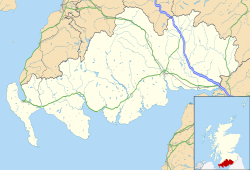Mull of Galloway
Human settlement in Scotland From Wikipedia, the free encyclopedia
The Mull of Galloway (Scottish Gaelic: Maol nan Gall, pronounced [mɯːlˠ̪ nəŋ ˈkaulˠ̪]; grid reference NX158303) is the southernmost point of Scotland. It is situated in Wigtownshire, Dumfries and Galloway, at the end of the Rhins of Galloway peninsula.
Mull of Galloway
| |
|---|---|
 Mull of Galloway headland | |
Location within Dumfries and Galloway | |
| OS grid reference | NX 15747 30411 |
| • Edinburgh | 112 mi (180 km) |
| • London | 292 mi (470 km) |
| Council area | |
| Lieutenancy area | |
| Country | Scotland |
| Sovereign state | United Kingdom |
| Post town | STRANRAER |
| Postcode district | DG9 |
| Dialling code | 01776 |
| UK Parliament | |
| Scottish Parliament | |
The Mull has one of the last remaining sections of natural coastal habitat on the Galloway coast and as such supports a wide variety of plant and animal species. It is now a nature reserve managed by the RSPB. Mull means rounded headland or promontory.
The Mull of Galloway Trail, one of Scotland's Great Trails, is a 59 km (37 mi) long-distance footpath that runs from the Mull of Galloway via Stranraer to Glenapp near Ballantrae, where the trail links with the Ayrshire Coastal Path.[1]
Lighthouse
Summarize
Perspective
 Lighthouse on the Mull of Galloway | |
 | |
| Location | Mull of Galloway Wigtownshire Scotland United Kingdom |
|---|---|
| OS grid | NX1569230398 |
| Coordinates | 54.635005°N 4.857416°W |
| Tower | |
| Constructed | 1830 |
| Designed by | Robert Stevenson |
| Construction | masonry tower |
| Automated | 1988 |
| Height | 26 metres (85 ft) |
| Shape | cylindrical tower with balcony and lantern |
| Markings | white tower, black lantern, ochre trim |
| Operator | South Rhins Community Development Trust [2] [3] |
| Heritage | category A listed building |
| Light | |
| Focal height | 99 metres (325 ft) |
| Range | 28 nautical miles (52 km; 32 mi) |
| Characteristic | Fl W 20s. |
An active lighthouse is positioned at the point. Built in 1830 by engineer Robert Stevenson, the white-painted round tower is 26 metres (85 ft) high. The light is 99 metres (325 ft) above sea level and has a range of 28 nautical miles (52 km).[4] The lighthouse and lighthouse keepers' houses are designated as a Category A listed building.[5]
During World War II, on 8 June 1944 at 7.30 pm, a French member of the British Air Transport Auxiliary (ATA), Cladius Echallier, died by striking the Lighthouse in a Beaufighter, while making a low landfall from the Irish Sea.[6]
The lighthouse is now automatic, and an old outhouse has been converted into a visitor centre, run by the South Rhins Community Development Trust, a group of local people and businesses. In 2013 there was a community buyout and the Mull of Galloway Trust purchased land and buildings, with the exception of the tower, from Northern Lighthouse Board.
In 2004 a new café was built at the Mull of Galloway, called the "Gallie Craig". Its design incorporates into the landscape with a turf roof, giving views across to Northern Ireland and southwards to the Isle of Man.
See also
- List of extreme points of the United Kingdom
- List of lighthouses in Scotland
- List of Northern Lighthouse Board lighthouses
- Dunnet Head - Scotland's most northerly point on the mainland
- Corrachadh Mòr - Scotland's most westerly point on the mainland
- Keith Inch - Scotland's most easterly point on the mainland
References
External links
Wikiwand - on
Seamless Wikipedia browsing. On steroids.

